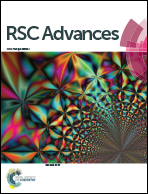Inorganic–organic hybrid NiO–g-C3N4 photocatalyst for efficient methylene blue degradation using visible light†
Abstract
Inorganic–organic hybrid NiO–g-C3N4 photocatalysts with different NiO contents were prepared through a simple calcination method. The as-prepared photocatalysts were characterized by powder X-ray diffraction (PXRD), thermo-gravimetric analysis (TGA), the Brunauer–Emmett–Teller (BET) method, high-resolution transmission electron microscopy (HR-TEM), and UV-vis diffuse reflection spectroscopy (UV-vis). The photocatalytic degradation of methylene blue (MB) over NiO–g-C3N4 was investigated. The incorporation of NiO caused a red-shift of the UV-vis absorption edge of g-C3N4. And the NiO–g-C3N4 photocatalysts exhibited a significantly enhanced photocatalytic activity in degrading MB using visible light, and the optimum hybrid photocatalyst with 6.3 wt% NiO showed a 2.3 times enhanced MB degradation rate. The improved photoactivity of NiO–g-C3N4 photocatalysts could be ascribed to the effective interfacial charge transfer between NiO and g-C3N4, thus suppressing the recombination of the photoexcited electron–hole pairs. Furthermore, the NiO–g-C3N4 photocatalyst showed excellent stability for the photocatalytic degradation of MB.


 Please wait while we load your content...
Please wait while we load your content...